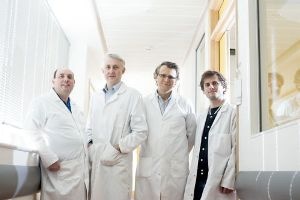Nov 24 2016
 L-R: Dr Marc Walker in the Department of Physics, with Professor Richard Walton, Dr Ross Hatton, and PhD student Kenny Marshall in the Department of Chemistry (credit: The University of Warwick)
L-R: Dr Marc Walker in the Department of Physics, with Professor Richard Walton, Dr Ross Hatton, and PhD student Kenny Marshall in the Department of Chemistry (credit: The University of Warwick)
Thanks to a team of researchers at the University of Warwick, a breakthrough in solar power could make it more economical and commercially feasible. In a research paper published in Nature Energy, Dr Ross Hatton, Professor Richard Walton and colleagues, state how solar cells could be manufactured in a more adaptable and simpler manner than their existing counterparts.
This could lead to more extensive use of solar power, with possible uses in products such as mobile phones, laptop computers, and cars.
Solar cells based on a group of semiconductors called lead perovskites are quickly emerging as an efficient way to turn sunlight directly into electricity. However, the reliance on lead is a serious barrier to commercialization, due to the recognized toxicity of lead.
Dr Ross Hatton and colleagues demonstrate that perovskites using tin instead of lead are much more stable than formerly thought, and could turn out to be a feasible substitute to lead perovskites for solar cells.
Lead-free cells could cause solar power to become cheaper, safer and more commercially appealing - resulting in it becoming a more widespread source of energy in daily life.
The team has also demonstrated how the device structure can be significantly simplified without diminishing performance, which offers the vital advantage of decreased fabrication cost.
Dr Hatton explains that there is a great demand to develop renewable sources of energy.
It is hoped that this work will help to stimulate an intensive international research effort into lead-free perovskite solar cells, like that which has resulted in the astonishingly rapid advancement of lead perovskite solar cells. There is now an urgent need to tackle the threat of climate change resulting from humanity’s over reliance on fossil fuel, and the rapid development of new solar technologies must be part of the plan.
Dr Ross Hatton, University of Warwick
Perovskite solar cells are compatible with flexible substrates and lightweight, so they could be used more extensively than the rigid flat plate silicon solar cells that presently control the photovoltaics market, especially in transportation and consumer electronics applications.
The research paper, ‘Enhanced Stability and Efficiency in Hole-Transport Layer Free CsSnI3 Perovskite Photovoltaics’, is published in Nature Energy, and is authored by Dr Ross Hatton, Professor Richard Walton and PhD student Kenny Marshall in the Department of Chemistry, along with Dr Marc Walker in the Department of Physics.